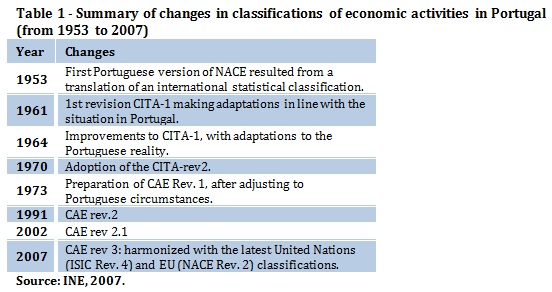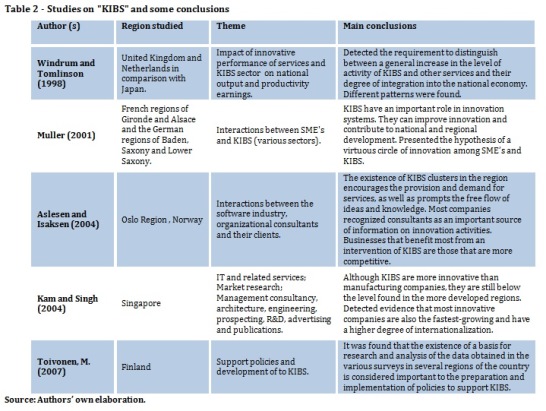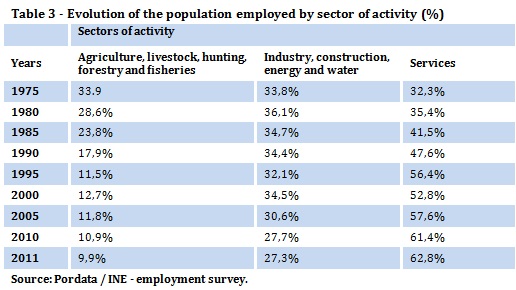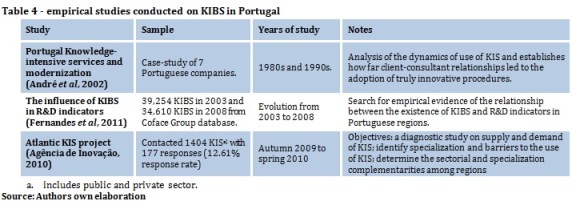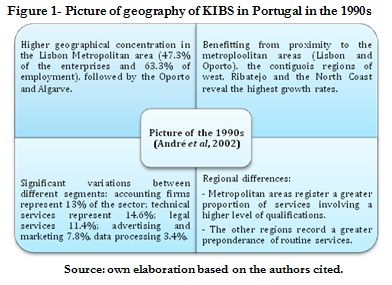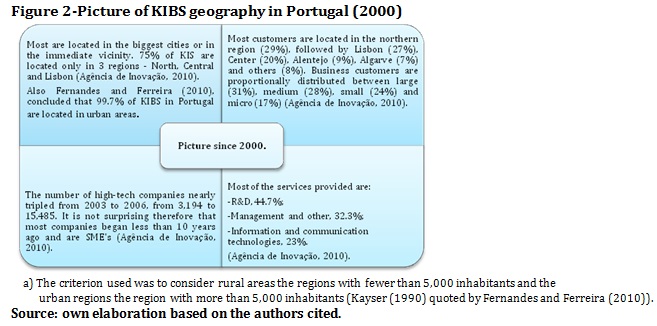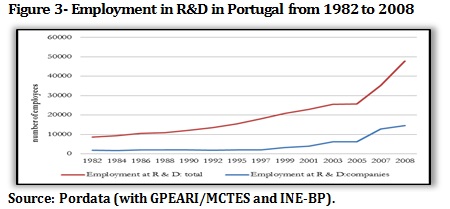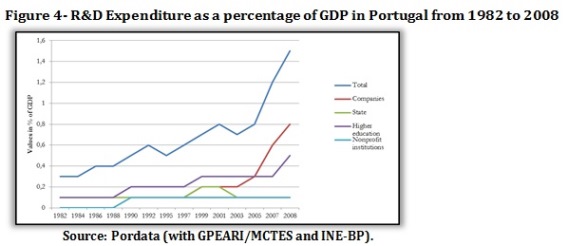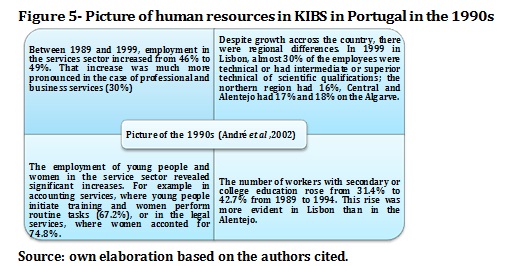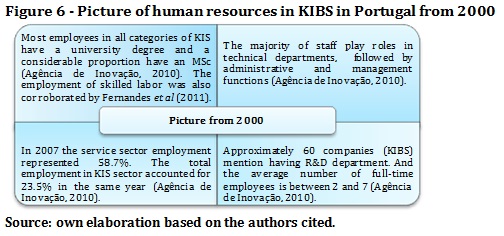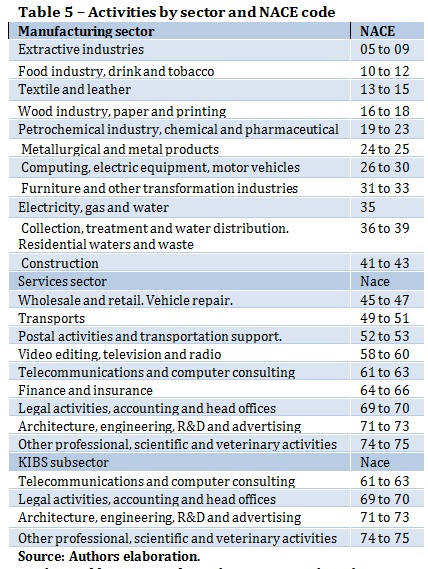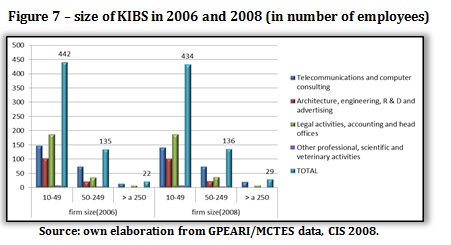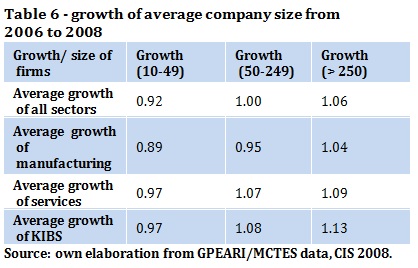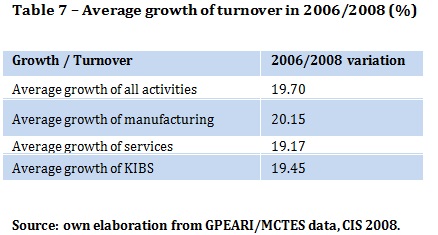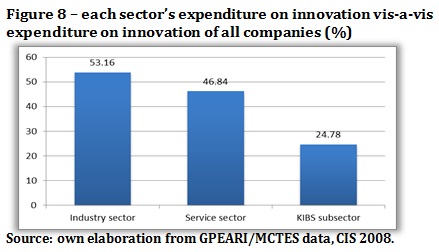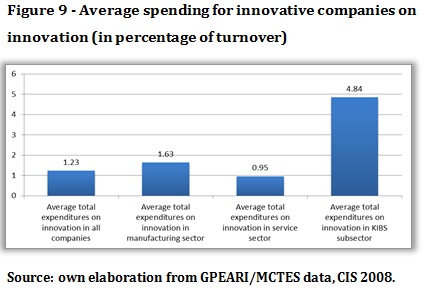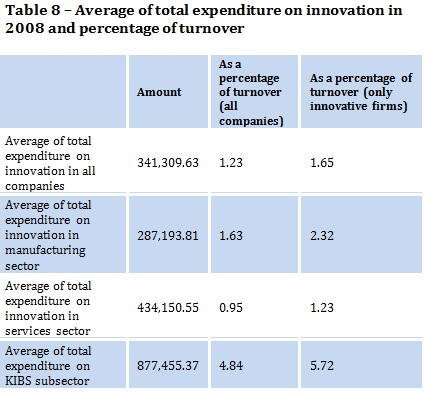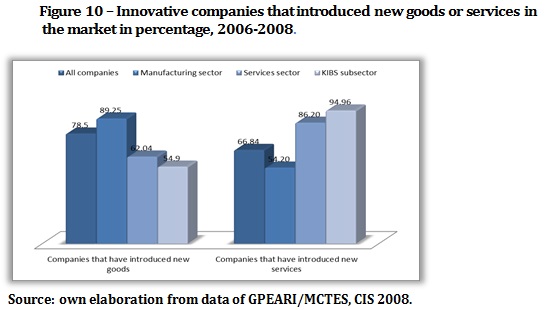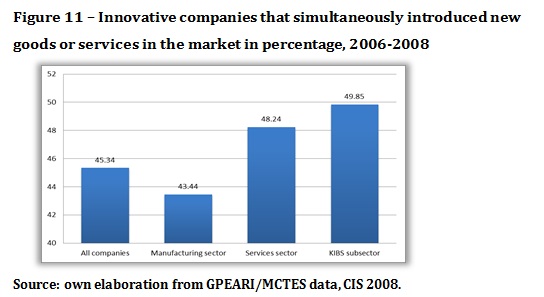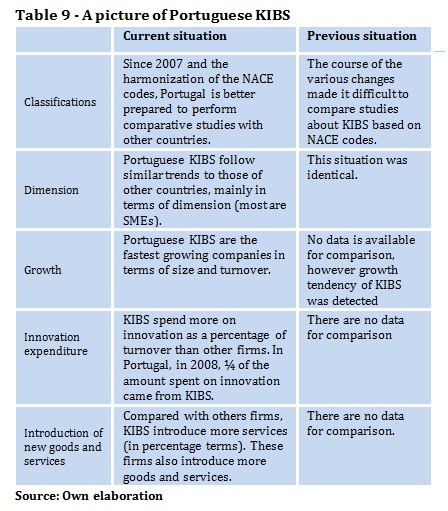Serviços Personalizados
Journal
Artigo
Indicadores
-
 Citado por SciELO
Citado por SciELO -
 Acessos
Acessos
Links relacionados
-
 Similares em
SciELO
Similares em
SciELO
Compartilhar
Tourism & Management Studies
versão impressa ISSN 2182-8458
TMStudies vol.9 no.1 Faro 2013
Portuguese knowledge intensive business services: What do we know about them?
O que sabemos sobre os knowledge intensive business services portugueses?
Luísa Carvalho1, Sandra Pinto2
1 Department of Economics and Management, Polytechnic Institute of Setúbal and CEFAGE- University of Évora, luisa.carvalho@esce.ips.pt;
2 UAIIDE- Polytechnic Institute of Setúbal, sandrapinto@sc.ips.pt
ABSTRACT
In Europe, most of the earlier studies applied to KIBS (knowledge intensive business services) were developed in North European countries (Finland, Sweden, Norway, UK or German) where that research is already consistent and widespread. However, the study of KIBS is in its infancy in other European countries. In this article we demonstrate that research into Portuguese KIBS is still very recent and incipient.
We also aim to contribute to the discussion of the significance of KIBS to Portuguese economy where the weight of services sector is preponderant.
We present a literature review showing how the KIBS have evolved in Portugal by drawing portraits of two decades. We complement this with an empirical study using the Community Innovation Survey (CIS) 2008.
We emphasize that there is still much to learn about Portuguese KIBS.
Keywords: KIBS, CIS 2008, Portugal, evolution, innovation.
RESUMO
A maior parte dos estudos europeus sobre KIBS (knowledge intensive business services) foram desenvolvidos em países da Europa do Norte (Finlândia, Suécia, Noruega, Reino Unido ou Alemanha), onde esses estudos já são consistentes e esse conhecimento já está disseminado. Contudo, noutros países da Europa, o estudo encontra-se ainda na sua infância. Neste artigo pretendemos demonstrar que o estudo dos KIBS portugueses é ainda muito recente e insipiente.
É também nosso objectivo contribuir para a discussão sobre a importância dos KIBS para a economia portuguesa, onde o peso do sector dos serviços é preponderante.
Apresentamos uma revisão de literatura que mostra como evoluíram durante duas décadas os KIBS portugueses e apresentamos alguns retratos dessa evolução. Esta revisão é complementada com um estudo empírico para o qual foram utilizados os dados do Inquérito Comunitário à Inovação (CIS) 2008.
Envidenciamos que ainda há muito a aprender sobre os KIBS portugueses.
Palavras-chave: KIBS, CIS 2008, Portugal, evolução, inovação.
1. Kibs – some important remarks
KIBS are currently known as a subsector of the service sector. These services are distinguished by their characteristics and are part of the so-called KIS-knowledge intensive services, which aggregate public and private services entailing the commercial use of intensive knowledge. Both sides (public and private) belong to the knowledge-based economy. This economy is characterized by the on-going requirement not only for codified learning but also the necessary skills to apply this knowledge (OECD, 1996).
In the late 1980’s and early 1990’s, researchers detected specific traits of some service sector firms that currently can be summarized as follows:
- Companies or private organizations (Bilderbeek et al, 1998);
- Based on professional knowledge (Bilderbeek et al, 1998; Miles, 2007);
· Use of knowledge based on science and technology (Miles, 2007);
· Represent sources of information and knowledge (e.g. consulting and reports), (Miles et al, 1995);
· Apply their own knowledge to produce intermediary services to be introduced in the productive processes of their customers (Bilderbeek et al, 1998; Miles et al, 1995);
· Have a competitive importance mainly applicable in the business context (Miles et al., 1995).
· Are innovative and exhibit many similar features to high-tech manufacturing (Miles et al, 1995; Miles, 2007; Doloreux et al, 2010).
Influence their customers’ choice and use of new forms of innovation and organizational practices (Miles, 2007).
In addition to the above features , Miles et al (1995) refer the importance of KIBS companies in the process of knowledge transference between companies. Miles (2007: 293) also states that " KIBS are agents for creating, integrating and bearing knowledge” and stresses the role of KIBS in this transference and dissemination.
The study conducted by Hertog and Bilderbeek (1998) highlights some important aspects relatively to KIBS:
· KIBS are catalysts in the creation of knowledge and innovation processes for their clients’ companies. Knowledge can be created by them or developed in cooperation with their clients;
· KIBS play a role that enables knowledge conversion processes, helping their clients to become learning organizations;
· The intervention of KIBS is mainly process oriented, non-contractual and implies the use of tacit knowledge.
· The experience in the development of a project could be used as a basis for developing new services and to provide solutions to solve some similar problems faced by future clients.
In summary, KIBS are considered vital to enhancing the competitiveness of developed economies. They also play a central and broader role in the diffusion of concepts and innovative ideas, as a source of intangible capital and in initiating and developing activities that support other sectors in their innovation process.
2. KIBS – difficulties in the classification
Nowadays, there is little controversy about the classification of KIBS. The classifications were so diverse in the past (e.g. NACE) in several countries that it was difficult to build a comprehensive organization of KIBS.
Moreover, the following questions should be underlined:
Can we distinguish and group KIBS?
Is it possible to make comparisons between countries or even regions?
A temporal comparison is even more complicated as it also limits comparisons and longitudinal studies and the codes have changed over the years e.g.– NACE was revised several times in Portugal (CAE Rev. 1, 2.1 and 3).
Focussing on the Portuguese case in particular, Table 1 summarizes the main changes that have taken place over the past 60 years.
Hales (1998: 1) describes the difficulties arising from the changes: “ mapping and measuring of services is fundamentally difficult both because they are a residual category in classifications of industrial activity and because they are changing significantly in both structure and function ". A similar problem was reported by Bilderbeek et al (1998) in their study of T-KIBS.
In fact, only a correct identification (of both providers and activities) can prevent the generalization of KIBS (Doloreux et al., 2010). Miles et al (1995), the IOIR (2003), and the OECD (2005) also noted that the variety of classifications for services was one of the problems that prevented an accurate view of the differences and similarities between them. A further problem facing researchers is that this group is essentially formed by SME's(IOIR,2003; Agência de Inovação, 2010).
Over the years, empirical studies have been conducted on various types of KIBS. Table 2 brief describes some of the main studies identified in the literature according to the region, the theme and the main conclusions.
3. Portuguese KIBS: a literature review complemented by empirical evidence
A number of authors (Miles et al, 1995; Hertog and Bilderbeek,1998; Hipp, 2000; André et al, 2002; Miles, 2007) consider KIBS to be agents of dissemination and transference of knowledge and innovation for their clients, that cannot be dissociated from the national/regional economic and social environment (macro and micro). Moreover, it is reasonable to assume that KIBS present particular characteristics in each country or region, which can be explained by their specific social and economic conditions. André et al (2002) describe the economic and social context in Portugal from a historical perspective.
Portuguese history and evolution of its economy since the mid-20th century have influenced the current state of Portuguese KIBS.
The process of economic openness and integration in Europe goes back to 1959 (the year of the accession to the EFTA-European Free Trade Association) and it was after this that the conversion of manufacturing sector and economic growth began (Santos, 1977).
Significant changes took place in Portugal’s economic structures between 1968 and 1974. The steel, chemical and shipbuilding industries emerged in the periphery of Lisbon triggering widespread migration from rural to urban regions and contributing to the increase of the secondary sector. During this period, large industrial groups were developed and the country benefited from foreign investment and trade (Santos, 1977).
This fostered the demand for business services such as market research. The large international consultancy firms were established in Portugal at this time (André et al, 2002).
The 1974 revolution was another milestone in Portugal's economic history as it led to democracy and political openness in the country as well as to some political and economic instability. The economic, financial and legal issues that arose due to greater difficulties and political instability in this period resulted in the development of other consulting activities, e.g. financial and legal (André et al, 2002).
During the 1980’s, Portugal accompanied the worldwide development of information technology and the expansion of the leading consulting companies (André et al, 2002).
The second half of the 1980s was marks by Portugal’s accession to the EEC (European Economic Community) when it received funds to develop the country and promote economic and social convergence with Europe. This resulting surge in demand for business services for consulting projects was followed by a significant increase in the number of KIBS in Portugal; the change in the productive structure gathered pace and the weight of services in the Portuguese economy increased(André et al, 2002; Royo, 2010).
Table 3 presents the evolution of the population employed by sector since 1975 and the evolution of the economic structure. In 1975, there was a reasonable balance of employment across the three production sectors but this changed steadily; the primary sector fell from 33.9% to 9.9%, and the secondary sector remained fairly stable until about 2005 when it started to decline. In contrast, the tertiary sector almost doubled over the period.
Although the Portuguese service sector has grown over the last 35 years, few empirical studies have focussed specifically on the service subsector of Portuguese KIBS (Sarkar et al, 2008; Carvalho and Costa, 2010; Pinto and Carvalho, 2011). Table 4 outlines the studies on Portuguese KIBS, the sample, years of study and some findings.
3.1. Geography and territory
A number of researchers (Aslesen and Isaksen, 2007; Fernandes and Ferreira, 2010) sought to understand and map KIBS across the territory and identified reasons for their different geographic distributions, such as interactivity, the sensitivity of the market or the quality and type of knowledge (Wood, 2003).
Marshall and Wood (1995:39) emphasize the question of spatial concentration highlighting that “ services are central to modern economic restructuring and growth, but they play many different roles, in different economic and geographical circumstances. In some cases they follow, and in others they lead wider patterns of restructuring. |...|The complexity and diversity of much interaction in modern services also encourages their spatial concentration" .
Some empirical studies note that certain types of KIBS are concentrated in specific regions and also suggest reasons for this:
· Aslesen and Isaksen (2007): two KIBS sectors were studied (organizational consultants and software development) in Oslo, Norway. The proximity proved important since many projects require cooperation with customers;
· Hyypiä and Kautonen (2005): although they concluded that geographical proximity per se does not guarantee the existence of KIBS-customers relations, they argue that a certain degree of proximity is an important condition for the maintenance of these relationships.
The geographical concentration is analyzed in literature from both the supply and demand sides (Bilderbeek et al, 1998; André et al, 2002; Aslesen and Isaksen, 2007; Agência de Inovação, 2010).
In order to understand the geographical location of KIBS in Portugal we draw some pictures.
Figure 1 reveals some marked differences in the spread and geographical concentration both in terms of the number of companies and the type of activities.
In Figure 2 we present the geographical concentration in urban regions and note marked differences in the activities carried out by KIBS from the year 2000.
Aslesen and Isaksen (2007:8) provide a clear explanation for the concentration of KIBS in urban areas :
"Urban businesses have better access to such services than do firms in other regions, in particular compared to those in peripheral areas. Thus, urban businesses can be more frequent users of knowledge services that are most efficiently offered by close proximity than firms located in other areas. And firms that benefit from geographical proximity to knowledge intensive services may choose to locate in urban areas. Consequently there is an increased demand for knowledge intensive services from urban firm, leading to a further increased supply of such services in big cities, which in turn stimulates the demand, and so on."
On the other hand, some researchers also note that an environment conducive to the development and appropriation of knowledge is fundamental for knowledge transfer. Such argumentation is presented according to Cohen and Levinthal (1990), in their theory of the absorption capacity. Those authors have defined as “absorptive capacity”, “ the ability to exploit external knowledge|…|. |…| the ability to evaluate and utilize outside knowledge |…|. |…|an ability to recognize the value of new information, assimilate it, and apply it to commercial ends ”(Cohen and Levinthal, 1990: 128). On the other hand, Roper and Love (2006) argue that a regional absorption capacity is conditioned by the existence of a labour market with more or less absorption capacity.
3.2. Human resources, R&D and innovation in KIBS
Evidence suggests that the nature and knowledge base of KIBS is such that the academic level of their employees is higher than that of the average company (Miles, 2007).
André et al (2002: 292) also mention that “ In the European context, the average education level in business services in Portugal is low, but it is much higher than the national average”.
Figure 3 and Figure 4 show the distribution of employment in R&D in Portugal. After a period of relative stability until 1997, companies in the sector clearly took off and R&D spending in 2008 reached 0.8% of GDP (more than 50% of the total) and approximately 30% of all personnel employed in R&D worked in R&D companies.
Fernandes et al (2011: conclusion) concluded whit their multivariate analysis that " changes in R&D indicator are explained by the number of KIBS. |…|This relationship allows us to infer that where there are more knowledge-intensive firms are also more persons with higher education. |...| Thus, we can still say that these knowledge-intensive companies have a significant impact on the employment of skilled labor in the regions where they are located ”.
Given the above mentioned importance of the region and proximity, the cities and especially those that have centres of knowledge (typically universities and research centres), are presented as areas where the most skilled human resources are concentrated. Those areas are one of the factors presented that influence the concentration of KIBS.
In Figure 5 we show the human resources employed in KIBS in Portugal and highlight some changes in the numbers and their skills. It also reveals some geographical differences.
Figure 6 summarizes the skills of KIBS employees since 2000, considering job and R&D departments creation.
4. KIBS in Portugal: an analysis supported on CIS 2008
The literature review is now complemented by a descriptive analysis with the Portuguese Community Innovation Survey 2008 in order to improve the characterization of this subsector. Activities were differentiated as set out in Table 5.
Analysis of Figure 7 confirms that most KIBS have between 10 and 49 employees (74% in 2006 and 73% in 2008), with only a small minority having over 250 employees (3.7% in 2006 and 4.8% in 2008). This was also the case in other countries and regions, e.g. Singapore (Kam and Singh, 2004), Navarra and Galicia in Spain, Brittany in France, Devon and Cornwall in the United Kingdom, and the South East and Border, Midland and Western regions of Ireland (AKP, 2011).
Literature review and empirical studies of other countries (Windrum and Tomlinson, 1998; Muller, 2001; Kam and Sing, 2004; Corrocher et al, 2008;) reveal that the KIBS subsector has been in a continuous growth. The data for these variables is set out in tables 6 and 7 to confirm whether or not there is a similar trend in Portugal.
Table 6 compares the average growth of all sectors (including KIBS), with the average growth of KIBS. It is important to note changes in KIBS size. Most companies reported that the number of employees rose the 10-49 category to that of 50-249 employees. This trend is not surprising and indeed KIBS are sometimes referred in the literature “fast growing gazelles” (Henrekson and Johansson, 2010; Acs, 2011).
Table 7 presents the change in turnover between 2006 and 2008. It suggests that the increase in size is accompanied by a rise in turnover. It also shows that increase in company size and turnover was higher in KIBS than in service sectors.
A comparison of the figures for human resources in KIBS in the 1990s and since 2000 reveals a trend of specialization and increased qualifications in these companies and the development of innovation and R&D departments.
It is now important to analyze the practical consequences of these changes in the development of innovation in KIBS and to explore their influence. Figure 8 illustrates the volume of expenditure on innovation in each sector as well as the total volume of spending on innovation. The manufacturing sector represents 53.16% of total expenditure on ; a similar situation is found in other countries, like Singapore (Kam and Singh, 2004; Wong and He, 2005) and United Kingdom (Miles, 2007).
The service sector contributes with 46.84% of the total spent on innovation, 24.78% of which comes from the KIBS subsector (note that in this graph, the value of KIBS is included in the service sector). The significance of this Figure 8 is clear given that KIBS represent only 9.55% of the companies and 6.23% of total turnover of the sample.
Figure 9 gives a broader perception of the proportion of spending on innovation in each of the major sectors. Manufacturing sector and the companies that innovate in this sector spend 1.63% of their turnover on innovation. The services sector spent 0.95% and KIBS subsector spent 4.84% on innovation. These results enhance the value of the subsector KIBS .
In order to highlight the above, we use the following citation from IOIR(2003:9), “ Analyses of earlier CIS data for the whole EU have indicated that the proportion of innovators is highest amongst the technology-oriented services, such as IT services and technical services. Their reported innovation levels are comparable to high-tech manufacturing .”
Table 8 complements this data by showing both the amount and percentage of the average expenditure on innovation. It shows that KIBS not only spend more on innovation as a percentage of turnover, but also contribute most to the average amount.
As shown in the Table 8, KIBS spent an average of 877,455.37 euros on innovation compared with only 341,309,63 euros by the total number of companies in the sample; they even spend twice as much as the services sector as a whole (a figure already influenced by the KIBS).
In order to understand how the spending on innovation originates outputs, the next Figure 10 illustrate the results of two variables, namely introduction of new goods or introduction of new services and reveal the following:
· KIBS introduce fewer new goods and services than the manufacturing and services sector as a whole. Manufacturing sector introduces the most goods (89.25%).
· KIBS firms are worth almost 95% of the introduction of new services. This is 8% higher than services sector, when aggregated.
If we analyze the companies that introduced new goods and services on the market simultaneously, we see from Figure 11 that KIBS record the largest percentage. KIBS represent 49.85% of all companies. This is greater than the aggregate service sector, which records 48.24% and manufacturing sector which records 43.44%.
5. Concluding remarks
There has been growing interest in researching KIBS in recent, particularly the late 1980s and 90s and following the continued interest in the service sector as a whole.
KIBS is distinct from the service sector in a number of ways, notably:
· The different types of KIBS (technological - T-KIBS or professional - P-KIBS);
· The different geographies and their impact on innovation systems and regional locations;
· Their role as a vehicle for the transfer of knowledge to their clients;
- Their propensity for innovation;
· Their superior innovative performance compared with other companies;
- Their fast growth.
This study summarizes the research on Portuguese KIBS through a literature review, notably on the different facets of KIBS and studies of other regions and countries. A historical analysis concluded that Portuguese KIBS have made a positive evolution over the last 20 years (1990-2008).
Examples of changes during this period were recorded in the activities KIBS have changed over this period from mainly legal support services, accounting or advertising in the early 1990's to R&D services, management and information technologies since the turn of the century.
Reference was also made throughout this study to the changes in the type of human resources working this subsector and the rise in the number of qualified personnel. It should also be noted that Portuguese KIBS reveal similar trends to those in other regions or countries:
- They consist mainly of SMEs;
· Their growth rate is higher than that of other firms i.e. in the manufacturing sector and service sector as a whole;
· They are concentrated around the most important urban centers.
The results of the descriptive analysis of the CIS-2008, combined with the literature review are summarized in Table 9.
While this study outlines current knowledge about Portuguese KIBS, and also reveals what we do not know about them (and therefore indicates future research paths):
· The different behaviors of several types of KIBS and their grouping according to their homogeneity or heterogeneity;
· The differences in propensity to innovation inside the group;
· The difference in the types of innovation engaged in;
· The degree of internationalization;
· The types of internal or external cooperation;
· The sources of information used in their innovation process;
· The degree and patterns of openness.
The priority for future research must be to increase knowledge about the above-mentioned aspects to permit a more precise mapping of Portuguese KIBS and also about its propensity to innovate.
One limitation of our study was precisely the lack of previous research about Portuguese KIBS which prevents comparisons. Nevertheless, public policies applied to innovation that involves KIBS must consider their importance as agents of growth and vehicles of innovation, particularly in developed countries.
References
Acs, Z. (2011). High impact firms: Gazelles revisited. In Michael Fritsch, Edward Elgar (Eds.), Handbook of research on entrepreneurship and regional development (pp. 133-174). Cheltenham: Edward Elgar. [ Links ]
Agência de Inovação. (2010). Knowledge Intensive Services Supply and Demand in Portugal. Retrieved September 15, 2011 from http://www.adi.pt/docs/AtlantKIS_AuditReport_September2010.pdf. [ Links ]
André, I., Feio, P. A. & Ferrão, J. (2002). Portugal: Knowledge-intensive services and modernization. In Peter Wood (Ed.), Consultancy and Innovation: the business service revolution in Europe (pp. 283-315). London: Routledge. [ Links ]
Aslesen, H. & Isaksen, A. (2007). Knowledge Intensive Business Services and Urban Industrial Development. Do KIBS cause increased geographic concentration of industries? The Service Industries Journal, 27(3), 321-338. [ Links ]
AKP – Atlantic Kis Project. (2011). Regional Audit of Knowledge Intensive Services Supply and Demand. Retrieved Setember 15, 2011 from http://www.atlantkis.eu/images/uploads/atlantkis_report_en.pdf. [ Links ]
Bilderbeek, R., Hertog, P., Marklund, G. & Miles, I. (1998). Services in innovation: Knowledge intensive business services (KIBS) as co-producers of innovation. International Journal of Innovation Management, 4(4), 491–528. [ Links ]
Cohen,W. & Levinthal, D. A. (1990). Absorptive Capacity: A New Perspective on Learning and Innovation. Administrative Science Quarterly, 35 (1), 128-152. [ Links ]
Corrocher, N., Cusmano, L. & Morrison, A. (2008). Modes of innovation in knowledge intensive business services- evidence from Lombardy. Journal of Evolutionary Economics, 19, 173-196. [ Links ]
Carvalho, L. & Costa, T. (2010). The Determinants -of Entrepreneurship Based on Innovation in Business Services Firms: An Empirical Model. In Aleksander Surdej & Krzysztof Wach (Eds.), Exploring the Dynamics of Entrepreurship (pp. 13-25). Toruń: Adam Marszałek Publishing House. [ Links ]
Doloreux, D., Freel, M. & Shearmur, R. (2010). The Study of Knowledge-Intensive Business Service and Innovation. Hungarian Geographical Bulletin, 61(3), 257–262. [ Links ]
Fernandes, C. & Ferreira, J. (2010). Knowledge Intensive Business Services: what are they and where are they located? Some portuguese evidences. Proceedings of the 3nd International Conference for Entrepreneurship, Innovation and Regional Development. Novi Sad: SEERC. [ Links ]
Fernandes, C., Ferreira, J. & Marques, C. (2011). A influência dos Knowledge Intensive Business Services (KIBS) nos indicadores de I&D: algumas evidências empíricas portuguesas. Paper presented at XXI Jornadas Hispano Lusas de Gestão Científica, Cordoba. [ Links ]
Hales, Mike. (1998). A tale of two sectors: issues in the mapping of knowledge Intensive Business Services. Retrieved September 15, 2011 from http://survey.nifu.no/step/old/Projectarea/si4s/papers/topical/si4s13.pdf. [ Links ]
Henrekson, M. & Johansson, D. (2010). Gazelles as job creators: a survey and interpretation of the evidence. Small Business Economics, 35(2), 227-244. [ Links ]
Hertog, P. & Bilderbeek, R. (1998). Conceptualising (service) innovation and the knowledge flows between KIBS and their clients. Retrieved September 15, 2011 from http://survey.nifu.no/step/old/Projectarea/si4s/papers/topical/si4s11.pdf. [ Links ]
Hipp, C. (1999). Knowledge-Intensive Business Services in the New Mode of Knowledge Production. AI & Society, 13, 88-106. [ Links ]
Hyypiä, M. & Kautonen, M. (2005). Expertise, Proximity and KIBS–Client Relationships Theoretical Considerations based on Empirical Observations on Service Interactions in Knowledge Intensive Industries in Helsinki, Finland. Paper presented at XV International Conference of RESER. ICT and Service Relationship in the Global Economy: A Challenge for Enterprises and Societies in Europe, Granada. [ Links ]
IOIR-Institute of Innovation Research. (2003). Knowing How, Knowing Whom: A Study of the Links between the Knowledge Intensive Services Sector and The Science Base. Manchester: University of Manchester/UMIST. [ Links ]
Instituto Nacional de Estatística-INE (2007). Classificação Portuguesa das Actividades Económicas, Revisão 3. Lisbon: Instituto Nacional de Estatística. [ Links ]
Kam, W. P. & Singh, A. (2004). The Pattern of Innovation in the Knowledge intensive Business Services Sector of Singapore. Singapore management review, 26(1), 21-44. [ Links ]
Marshall, J. N & Wood, P. (1995) Services and space: key aspects of urban and regional development. Harlow: Longman Scientific & Technical. [ Links ]
Miles, I., Kastrinos N., Bilderbeek, R., Hertog, P., Flanagan, K. & Huntink, W. (1995). Knowledge-intensive business services: their role as users, carriers and sources of innovation. Luxembourg: Commission of the European Communities. [ Links ]
Miles, I. (2007). Knowledge Intensive Services and Innovation. In J. Bryson & P. W. Daniels (Eds.), The Handbook of Service Industries (pp. 277-294). Cheltenham: Edward Elgar Publishing. [ Links ]
Muller, E. (2001). Inovation interactions between knowledge-intensive business services and small and medium-sized enterprises. an analysis in terms of evolution, knowledge and territories. Heidelberg: Physica-Verlag. [ Links ]
OCDE (1996). The Knowledge-based economy. Paris: OCDE Publishing. [ Links ]
OCDE (2005). Enhancing the Performance of the Services Sector. Paris: OCDE Publishing. [ Links ]
Pinto, S. & Carvalho, L. (2011). KIBS and the innovation processes: a literature review.
Policy Implications for Knowledge Intensive Business Services (KIBS) and Innovation in Regions in a Globalised Economy . Paper presented at the Third Research Seminar- Regional Geographies of KIBS, Faro.
Roper, S. & Love, J. H. (2006). Innovation and regional absorptive capacity: the labour market dimension. The Annals of Regional Science, 40(2), 437-447. [ Links ]
Royo, S. (2010). Portugal and Spain in the EU: paths of economic divergence (2000-2007). Análise Social, 45(195), 209-254. [ Links ]
Santos, A. R. (1977). Desenvolvimento monopolista em Portugal (fase 1968-1973): estruturas fundamentais. Análise Social, 13(49), 69-95. [ Links ]
Sarkar, S., Carvalho, L. & Costa, A. (2008).Innovation In Service Industry: An Empirical Study Applied To Knowledge Intensive Business Services. Paper presented at the 15 Th International Product Development Management Conference, Hamburg. [ Links ]
Toivonen, M. (2007). Innovation Policy in Services: the Development of Knowledge-intensive Business Services (Kibs) in Finland. Innovation: Management, Policy & Practice, 9(3/4), 249-261. [ Links ]
Windrum, P. & Tomlinson, M. (1998). Impact of kibs on international competitiveness - a UK-Netherlands comparison. Retrieved September 15, 2011, from http://survey.nifu.no/step/old/Projectarea/si4s/papers/topical/si4s10.pdf. [ Links ]
Wong, P. & He, Z. (2005). A Comparative Study of Innovation Behaviour in Singa-pore's KIBS and Manufacturing Firms. The Service Industries Journal, 25, 23-42. [ Links ]
Wood, P. (2003). Return to KISIN: reflections on KIBS and regional innovation. Paper presented at the XIII international conference of RESER: services and regional development, Mons. [ Links ]
Article history
Submitted: 28 June 2012
Accepted: 30 November 2012













